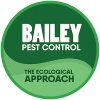Rats are one of the leading pests in the UK outnumbering the human population and are famously known for causing destruction and worry amongst households, businesses and local councils alike. Rats eat pretty much anything (including gnawing holes in your house) and are responsible for the spread of diseases such as salmonellosis (food poisoning) Weill’s disease, which can be fatal to humans. Along with disease rats are responsible for spreading parasites which is not good news for you and your lovable pets.
Preventing Rats Becoming Your Neighbours
Like most things preventing rats from establishing a home and leading to an outright rat infestation is the best pest control method. Once rats infest and are settled in, not only is disposing of the rats a worry but the habitat they have built (holes, pathways, burrows) are an inviting home for the next passing pest.
3 steps to prevention:
- Limit Access – rats only need a hole the size of a 10p coin to squeeze their greasy bodies through
- Limit Food Supply – fix water leaks and clear up food spillages
- Restrict Areas of Habitation – check areas which are not frequently used, when storing items or firewood, frequently visit the area (rats like quiet areas to nest and breed)
How to Spot a Rat Infestation
There are two types of rats founds in the UK, the brown rat (common rat) and black rat, both of which frequently grow up to 500grams in weight! Rats are most active at night and tend to like small dark places to use as highways to get to all their feeding zones. Rats are active throughout the year but in many cases you are more likely to find rats infesting your house during the winter when natural food sources are scarce and wet weather or snow forces them into a cosy shelter.
Most spot a rat infestation when it’s too late to try any DIY techniques such as buying a spring rat trap, more vigorous planned methods are often required from a specialist pest control expert.
To spot a rat, look out for:
- Rat dropping around where your pets eat
- Rat droppings in your bins (inside and out)
- Gnaw marks on doors/frames, beams and wires
- Sawdust/tiny bits of wood on carpets
- Droppings or small hairs in food cupboards
- Any evidence of holes in your flower bed or beneath a shed
- Damage to plants and garden items
- Urine stains and odors
- Greasy marks spotted about (rats have grease on their fur to help squeeze through small holes)
- Your pet cat/dog bringing in dead rats
- Footprints, rats foot prints are about 2cm long and 0.5cm wide
- Noises coming from the walls and attic just after dusk
- Finding remains of nest like structures in firewood stacks and storage areas
- Signs of eaten fruit that has fallen from a fruit tree in the garden
- Movements of something running seen in the corner of your eye
- Rats in seen in the street outside
- Dead rats seen in your street or garden
Rat Infestation Treatment
So now you have established there is a rat problem, but what should you do? Leave it as perhaps the rats may move on? Buy some springs traps? Or call in pest control? Well there is no harm done in setting a trap with a bit of bait but realistically if you have a noticed a rat problem (especially if it is inside a building) the problem is likely to be deep rooted and requires a professional pest control service. Often rat infestations are so vast due to rat breeding cycles that extensive methods of pest control are vital to succeed in beating the rat problem. Bailey Pest Control have years of experience in tackling rat infestation across Brighton & Hove and further afield in Sussex. Your rat infestation maybe bad but we have probably seen worse and we have tried and tested every single method of rat prevention and disposal known to the pest control industry. We can create the right pest control plan to combat your rat problem effectively and advise you how to prevent any future occurrences.
